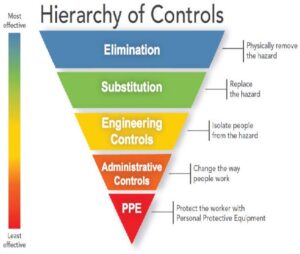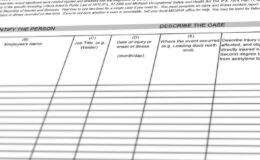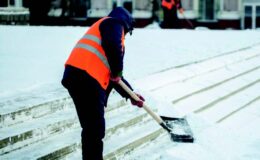Sean Heinonen
Loss Control Consultant
So you’ve taken the time to identify the hazards in your workplace, now what is your next step in protecting yourself or your employees? Did you know there is a hierarchy of 5 levels for determining the most effective control methods? These methods include elimination, substitution, engineering controls, administrative controls and personal protective equipment.
ELIMINATION: The first and best option will always be elimination. If you are able to physically remove the hazard from the workplace then there should be no need to take further action regarding the specific hazard, although you may want employees to be trained on recognition of the hazard if it has possibility of presenting itself again. An example may be ending the use of a hazardous material or performing a task at ground level instead of at heights, if possible.
SUBSTITUTION: This will be the next best option and is where you will be looking at replacing a material or process that will replace the hazard with a lesser hazard. An example of this could be switching a process that uses less force, speed, temperature or electrical current. You can use a vice to bend metal instead of using a hammer or other large force. This eliminates the striking motion and noise. For painting you can replace solvent based paints with water based paints and eliminate or reduce toxicity. Another option for your sand blasters would be switching your sand blast materials to a non-silica based medium.
ENGINEERING CONTROLS: If the hazard cannot be eliminated and is still present then we look at ways to engineer out what we can. Is there a way we are able to isolate people from the hazard? This is a very common method as we see it present with machine guarding, interlocks, guardrail systems and more. Bandsaws are a common machine that have an exposed blade presenting a laceration hazard. Physically guarding all parts of the blade except for the working portion will reduce possibility of injury.
ADMINISTRATIVE CONTROLS: When there is still a hazard present, and the previous controls have been implemented or are unable to be implemented then we look at changing the way people work. This step will include training, procedures, and warnings. Examples include equipment inspections, checklists, preventative maintenance, worker rotations, warning signs, horns, backup alarms, and training on all of these.
PPE (PERSONAL PROTECTIVE EQUIPMENT): Although one of the most popular methods, using PPE is actually the least desirable method of protection. Examples may be safety glasses, hard hats, steel toe boots, etc. This would not take away from a company policy of requiring certain PPE, such as safety glasses, for all people in a production area no matter the hazards present.
By utilizing the above mentioned hierarchy of controls, your company can work to eliminate or control hazards in the most effective way possible. When the top option is not feasible then move to the option below for the next best. Many hazards will require multiple control methods to be effective. If there is still a hazard after implementing a control then move to the next for continuation of controlling that hazard until employees are protected.
Of course, anyone can go above and beyond by requiring additional controls no matter the situation, as long as those controls are not creating additional hazards to employees. (You wouldn’t want all employees walking around the floor wearing welding masks just because you have one employee welding!)
Possibly one of the most important parts in hazard control is the ability to recognize hazards. Without recognition, hazards may go unnoticed, and employees may be injured before you are able to implement any control method. Train your employees on the hazards associated with their job tasks and around your workplace.
If you have any questions regarding using the hierarchy of controls and identifying hazards, please contact your Loss Control Representative, they will be happy to assist you further.





